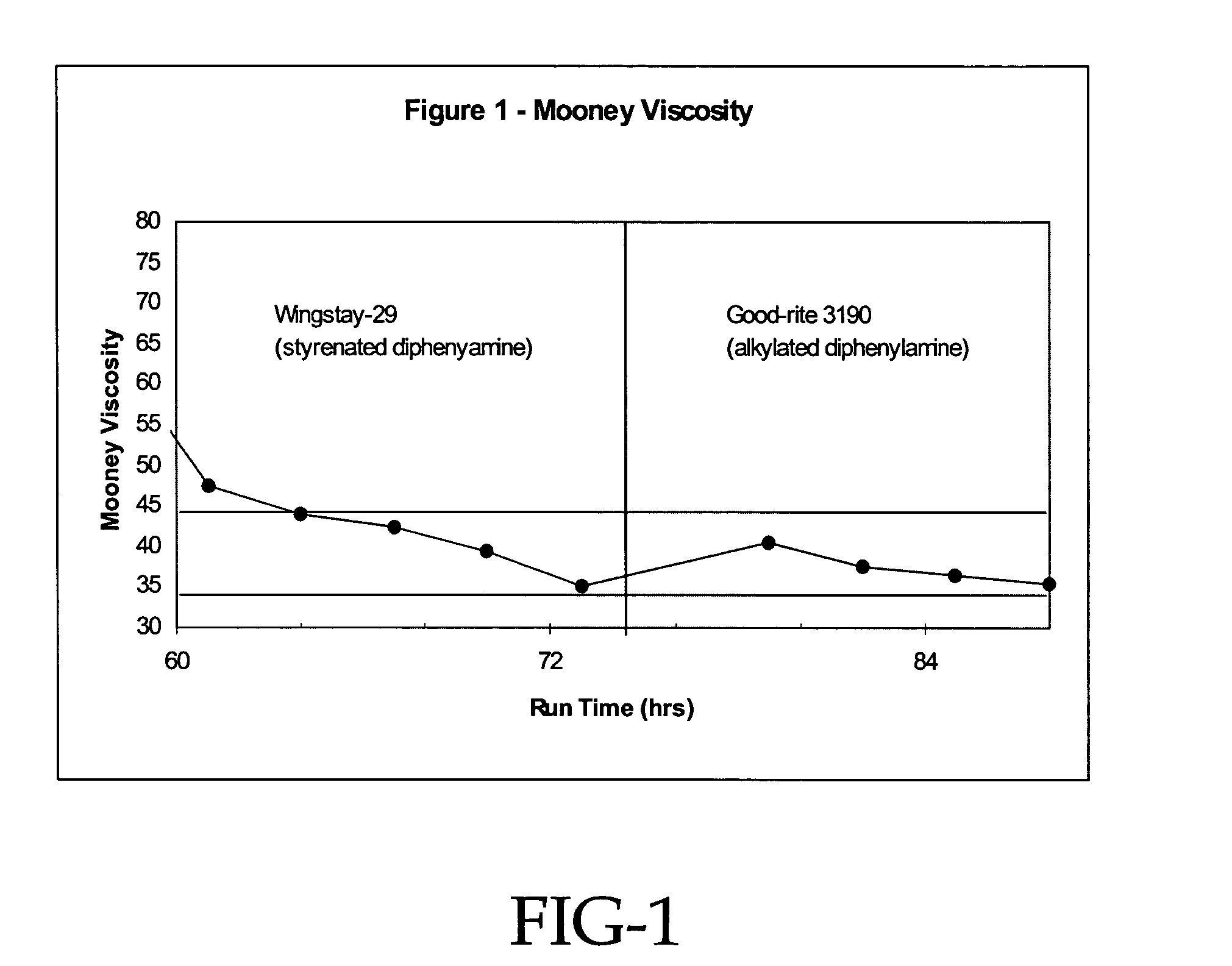Synthesis of 1,4-polybutadiene
a technology of polybutadiene and polybutadiene, which is applied in the field of synthesis of 1, 4polybutadiene, can solve the problems of increasing cold flow, preventing the use of cis-1,4-polybutadiene in many applications, and reducing the degree of branching, so as to reduce the molecular weight and reduce the level of branching , the effect of good processability
- Summary
- Abstract
- Description
- Claims
- Application Information
AI Technical Summary
Benefits of technology
Problems solved by technology
Method used
Image
Examples
examples 1 – 5
EXAMPLES 1–5
[0056]The following examples serve to demonstrate the unexpected finding that alkylated diphenylamines are as effective as para-styrenated diphenylamines at regulating molecular weight and polymer macrostructure in the polymerization of 1,3-butadiene with a nickel based catalyst system.
[0057]Materials—Butadiene was supplied by The Goodyear Tire & Rubber Company, and was freshly distilled prior to use. Hexane was supplied from Ashland Chemicals and purified by passing over an activated bed of silica gel under a dry nitrogen atmosphere. Nickel octanoate was provided by Shepherd as a 58 weight percent solution in mineral oil which was diluted to 0.01M in hexane prior to use. Triisobutylaluminum (TIBA) was supplied by Albemarle Corp. as a 25 weight percent solution in hexane and used as received. Hydrogen fluoride (HF) was supplied as a 25 wt % solution in butylether. HF was handled in Teflon bottles using neoprene gloves. Dilution to approximately 1 M in hexane was accompli...
examples 6 – 9
EXAMPLES 6–9
[0064]The following examples serve to demonstrate the unexpected finding that alkylated diphenylamines act as a general class of compounds effective at regulating molecular weight and polymer macrostructure in the polymerization of 1,3-butadiene with a nickel based catalyst system.
[0065]Evaluation of the effectiveness of other alkylated diphenylamines at regulating molecular weight was accomplished by comparing the Irganox-5057® alkylated diphenylamine to both Good-Rite® alkylated diphenyl amine and Wingstay® 29 styrenated amine. As shown in table 2, following the polymerization procedure in the previous examples, but at slightly higher total catalyst levels, both alkylated diphenylamines were effective at reducing molecular weight compared to the controls.
[0066]
TABLE 2Comparison of the other alkylated diphenylaminesAmineCementBrookfieldEntryAmineTypeAppearanceViscosity (cP)6nonenonemilky30,2007WS29styrenatedclear8,4708Good-Ritealkylatedclear11,6009Irg-5057alkylatedclear...
examples 10 – 22
EXAMPLES 10–22
[0067]To gain a better understanding of the sensitivity of viscosity reduction on the level of amine modifier present, a series of bottle polymerizations were conducted that varied in the amount of amine used from 30 equivalents to 50 equivalents. Polymerizations were again carried out at 65° C. for 90 minutes with a Ni charge of 0.014 phr and a TIBA:Ni:amine:HF ratio of 40:1:30–50:80. All polymerizations went to full conversion. Again, as evident in Table 3, the alkylated diphenylamine modifier was as effective as the styrenated diphenylamines. For example, in all cases, 30 eq of amine was not enough to provide full reduction of cement viscosity. By 40 equivalents, however, all four amines provided very similar viscosities versus the unmodified control.
[0068]
TABLE 3Molecular weight as a function of amine levels.BrookfieldMnEntryAmineEquiv.Viscosity (cp)(K)Mw (K)Mz (K)10WS293036,33011WS294024,07012WS295027,93013Good-Rite3031,2002376481,50814Good-Rite4021,4702075621,314...
PUM
| Property | Measurement | Unit |
|---|---|---|
| temperature | aaaaa | aaaaa |
| temperature | aaaaa | aaaaa |
| weight percent | aaaaa | aaaaa |
Abstract
Description
Claims
Application Information
 Login to View More
Login to View More - R&D
- Intellectual Property
- Life Sciences
- Materials
- Tech Scout
- Unparalleled Data Quality
- Higher Quality Content
- 60% Fewer Hallucinations
Browse by: Latest US Patents, China's latest patents, Technical Efficacy Thesaurus, Application Domain, Technology Topic, Popular Technical Reports.
© 2025 PatSnap. All rights reserved.Legal|Privacy policy|Modern Slavery Act Transparency Statement|Sitemap|About US| Contact US: help@patsnap.com



